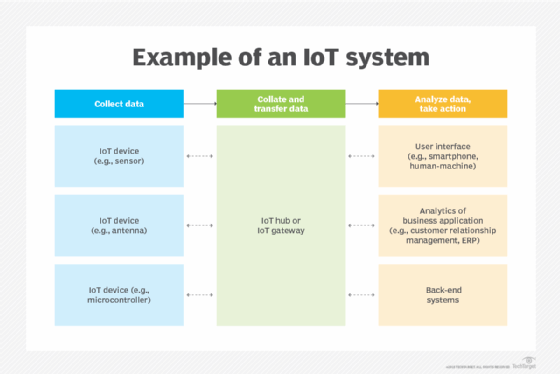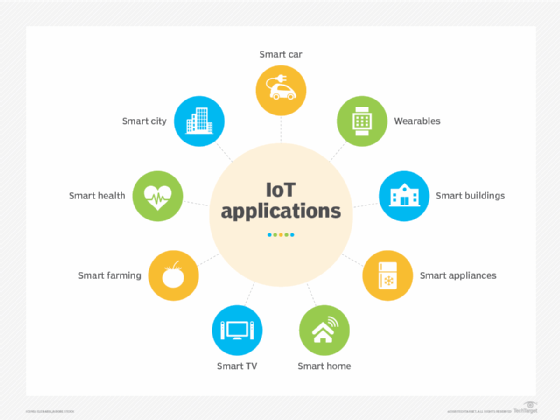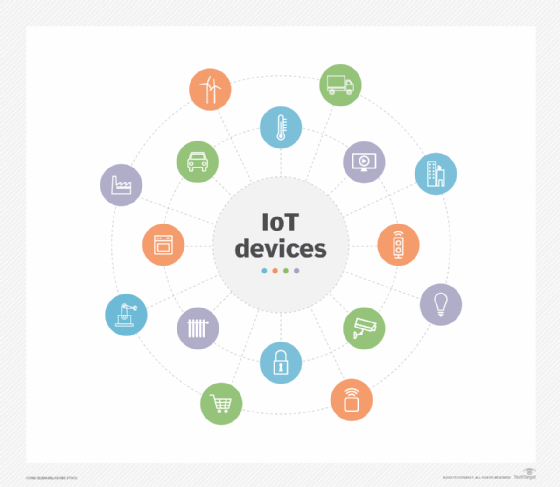IoT basics and fundamentals: A guide for beginners (original) (raw)
IoT stands for internet of things. Most simply, it refers to physical objects linked through wired and wireless networks. More specifically, it refers to the collection of internet-connected devices that are able to communicate autonomously over the internet, without needing a person to initiate the communication.
You might be asking yourself, how is this different from the "internet" as most people commonly understand the term? Well, it really isn't that different -- it's just a way of talking about the internet with a specific focus on "things" instead of people.
Let's delve into the basics of IoT, why it is important and applications of the internet of things in business and the consumer space.
What does IoT stand for and what does it mean?
Consultancy McKinsey & Company offered this basic description of IoT: "Sensors and actuators embedded in physical objects are linked through wired and wireless networks, often using the same Internet Protocol (IP) that connects the internet."
Kevin Ashton, who coined the term internet of things, preferred the term internet for things. While not widely used, this term provides a helpful way to understand the concept behind IoT. Think of the "normal" internet you access from your PC or smartphone as the internet for people and IoT as an internet of interrelated computing devices, mechanical and digital machines, objects, etc.
The internet of things is everywhere. It is used in a range of industries and has both corporate and consumer uses. Today, for example, automobiles often have dozens of sensors that collect and transfer data for safety, maintenance, entertainment, fleet management and other purposes. These internet-connected cars are considered part of the internet of things, because they communicate with other devices over the internet based on input from the environment, not just from direct human manipulation.
How does IoT work?
IoT works through a combination of wireless networking technology, physical devices, advanced data analytics and cloud computing. The basic process of how IoT works is as follows:
- A group of physical devices is wired or wirelessly linked to each other and/or a central area.
- The devices collect data from the external world using some kind of sensor.
- That data is then stored somewhere, whether it be in the cloud, an intermediary network location, or on the device itself.
- The data is then processed, often by machine learning and artificial intelligence.
- The processed data is used by the physical device to perform some action.
For example, this process as applied to a smart thermostat would go like this:
- The thermostat has a sensor that reads the temperature in the room.
- The thermostat stores and processes that data.
- If the temperature exceeds a certain value, the thermostat automatically regulates the temperature to some predefined value.
- The thermostat transmits periodic temperature readings to the energy provider's external database over a wireless network.
- A data analytics application derives insights from the data over time to improve energy efficiency by adjusting the thermostat's temperature settings.
Learn more about smart thermostats and other smart home technologies that use internet-connected devices for remotely managing appliances and systems.

This diagram illustrates an example of how an IoT system works: from data collection to collating and transferring data to analyzing that data and taking action.
Basic IoT fundamentals, concepts and terms
The four pillars of IoT and the main concepts to understand are:
- Data . IoT technologies provide myriad ways to collect data about the physical world. Data is the fuel of IoT and is why it is so important.
- Device . The actual, physical components or things in the internet of things that collect this data.
- Analytics . The process of making collected data useful by turning raw data into actionable insights.
- Connectivity . Makes sharing data and insights possible, increasing the value of that data. This is the internet in internet of things.
Closely related terms anyone getting acquainted with the concept of IoT should be aware of:
- Edge computing
- Big data analytics
- Artificial intelligence
- Machine learning
- Supply chain management
- Digital twin
- Machine-to-machine
- Operational technology
- Ambient intelligence
- Radio frequency identification
- Near field communication
- Person-to-person
- Machine-to-human
Specific types of IoT and its applications:
- Industrial internet of things (IIoT). Refers to the use of IoT in industrial applications.
- Internet of medical things (IoMT). The use of IoT in medicine.
- V2X communications (vehicle to everything communications). A vehicle's ability to sense its environment and communicate with it.
- Internet of battlefield things (IoBT). When IoT is used for military purposes.
Benefits of IoT technology
The internet of things' most immediate benefit for business is to help enterprises learn more about -- and thereby improve -- their own internal processes and structure to ultimately provide better products and/or more effective services. IoT increases the number and types of places enterprises can autonomously retrieve data from, providing much more information to work with. It also enables internal systems to become more responsive.
The main benefit of IoT for consumers is convenience and ease of use, which in the case of a healthcare device, for instance, is not trivial. As IoT grows and infiltrates the public sphere, more tangible and social benefits will crop up, including:
- Smarter environmental choices as a result of more accurate insights into our effect on the environment, pollution etc.
- Smart cities that revolutionize the way urban environments function.
- See changes in culture and politics as a result of these things. The massive amount of data that IoT networks and smart cities create will give people new insights into areas previously limited by the amount of real-time data available. Examples of this affecting politics would be the implementation of a location-free voting system and the pairing of biometric voter registration and authentication with IoT to ease voting and increase security
Challenges of IoT technology
Despite its potential, IoT faces several challenges, including:
IoT security. Oftentimes, IoT devices are meant to automate processes, and so humans don't interact with them as frequently as consumer devices like smartphones (itself a type of IoT device). For example, an administrator of an IoT device like a smart camera is more likely to neglect to change the default password set by the manufacturer. The result is an external-facing IoT device with a simple default password to crack.
Data privacy. There are also concerns about the data rights and privacy of consumer data as IoT becomes more prevalent. With more networked devices sharing data autonomously, being accountable for all that data becomes difficult; for example, billboards with hidden cameras that track demographic information of passersby who stop to read it (without their knowledge or consent), and securing patient data smart medical devices collect in and out of the hospital.
Safety. IoT devices -- especially those used in industrial, medical, transportation and infrastructural applications -- are often tasked with jobs that, if performed incorrectly, could put lives at risk. If a smart car's warning system malfunctions, it could cause the driver to neglect an obstacle or pedestrian. A malfunctioning sensor at an industrial plant can be catastrophic if a key warning sign is missed.
Interoperability. Many IoT devices have unique or niche protocols or proprietary services that they run on, and can't interact with other devices or services without considerable tweaking. There is also no universal standard set of terminology for talking about IoT, or a common set of regulations for when these devices see widespread adoption in the public sphere.
Environmental impact. Heavy metals used in many of IoT devices make it difficult to manufacture, dispose and recycle them without substantial environmental and human costs. Paired with this concern is how some IoT vendors intentionally brick (render useless) their products by disabling proprietary services that their devices need to run.

IoT examples in business and across industries
Medical. IoT devices can be used for medical data collection, monitoring and analysis. Sometimes referred to as smart healthcare, the internet of medical things aims to create a digitized healthcare system that connects medical resources and healthcare services.
Some examples IoT applications in this field include:
- Heart rate monitors and pacemakers that monitor a patient's vital functions and can send alerts through an emergency notification system.
- Advanced hearing aids that adjust their level of sensitivity to suit the user.
- Fitbits or smartwatches that measure biometrics.
- Smart beds that sense when a patient is moving to alert a healthcare professional or automatically adjust settings to improve comfort.
- End-to-end health monitoring applications that help patients -- with chronic illnesses, in particular -- monitor their vitals and medication requirements.
Military. The military uses smart technology and IoT to prepare for warfare and to conduct surveillance and reconnaissance. Examples include smart drones and the DARPA (Defense Advanced Research Projects Agency) Ocean of Things project, which aims to establish a network of passive sensors at sea to record the presence and activity of military and commercial vessels.
Manufacturing. IoT in the industrial and manufacturing sector aids in various sensing, identification, processing and communication processes in the factory and elsewhere. For example, digital control systems can automate these processes and help optimize plant safety, security and efficiency.
Retail. Retailers and distributors use smart packaging with a QR code or NFC tag that contains a unique identifier with digital information about products to enable digital interactions. Similar technology has been used during the COVID-19 pandemic to enable contactless interaction with publicly used objects, such as restaurant menus or smart water fountains.
Infrastructure. IoT devices can be used to improve public infrastructure. Some examples include:
- Transportation. Smart traffic control systems, smart parking systems, electronic toll collection systems and vehicle road assistance help make transportation more efficient.
- Home and building automation. Smart energy management systems monitor and control various infrastructural components.
- Infrastructure monitoring. IoT devices can monitor infrastructure like bridges or railway tracks to detect significant structural changes to improve emergency management and incident response processes.
- Urban development. Smart cities outfitted with IoT sensors provide citizens with services like environmental monitoring data and parking applications for their smartphones by way of smart meters.
- Agriculture. IoT is used in farming to monitor and collect agricultural data such as rainfall level, temperature, wind speed, pest infestation and soil content. Farmers can use the insights from IoT devices in their fields to improve the quality of their product and minimize waste.

IoT devices come in all different shapes and sizes.
Possible IoT uses for consumers
Smart homes and wearable devices are two common examples of IoT in the consumer market.
Smart homes often include smart devices and appliances, such as thermostats, lighting fixtures, cameras, security systems and toothbrushes, which are linked via a home network and may link out to other external networks via internet. A smart electronic toothbrush can transmit data about a user's brushing habits to their dentist to help provide more appropriate care, for example.
Users often control these devices and systems through smart speakers like Amazon Alexa and Google Home or a smartphone app. For instance, a user may use their smartphone to change the color of a smart lightbulb. Smart home devices can also assist those with mobility and sight limitations through voice assistants to help control smart appliances that would otherwise be difficult to access and manage.
Wearable IoT devices like Fitbits or Apple watches, meanwhile, use sensors to collect biometric data about a user for insights to improve physical health.